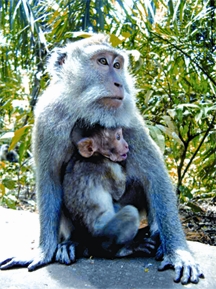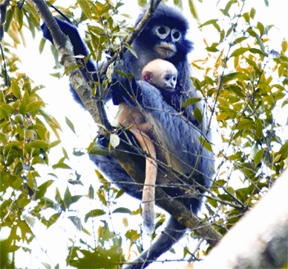Primates
Primates an order of the vertebrate class Mammalia that includes man, the apes, monkeys, lorises, and lemurs. Carolus Linnaeus used the name, meaning 'chiefs', in 1758. The majority of primates are adapted for life in trees, but many are ground dwelling. Some principally feed on leaves, fruits and different vegetable matter, while others are insectivorous; many eat fruits and leaves but also hunt live prey. Primates range in size from about 30 cm in marmosets, weighing less than a kilogram, to gorillas, which stand almost 200 cm high, and may weigh as much as 350 kg.
The first primates appeared in North America and Europe in the Palaeocene epoch (65-53 million years ago). Early forms such as Purgatorius were small and bore a striking resemblance to the living tree shrews. The lemurs and lorises are known as the lower primates or prosimians, while the monkeys, apes and man are variously called the higher primate, simians or anthropoids. The higher primates are divided into two major groups: the Platyrrhini (the New World monkeys), and the Catarrhini (the Old World monkeys, apes and man). Of the 180 or so species of living primates, 83 are Old World primates. Of these nine are gibbons. Gibbons are also known as lesser apes, while the Orang-utan, Gorilla and Chimpanzee are known as greater apes. Man is the only one to walk fully upright.
The use of tools and fire, and the ability to make clothes and efficient shelters have allowed man to penetrate nearly all climatic regions of the world. None of the great man-like apes are found in south Asia, the Gorilla and Chimpanzee occur in Africa, and the Orang-utan in Borneo and Sumatra. The only lesser ape inhabiting South Asia are the gibbons of which a single species, the Hoolock Gibbon or White-browed Gibbon (Hylobates hoolock), is found in the forests of Sylhet, Chittagong, and the Chittagong Hill Tracts. This species is also found in Assam in India.
Of the 180 or so known species of recent primates, 25 are found in South Asia. Bangladesh has 10 species in 4 families.
Some of them are threatened. Slow Loris (Nycticebus coucang) A member of the family Loridae. Face resembles that of lemur. Body dark ashy-grey or grey-brown with a darker band down the middle of the back; beneath lighter grey. Eyes owl-like, circled with dark patches. Head rounded, ear and tail very small.

Head-body length 26-40 cm; bulky, weight 1000-1600 g; generally solitary, nocturnal and arboreal. Movements slow, climbs readily with firm grips. Spends days curled in tree hollows. Feeds on leaves and shoots of trees, fruits, insects, bird eggs and young birds. A single young is born after a gestation period of c. 3 months. Occurs in the mixed evergreen forests of the country and also in deciduous forests of northern hilly areas.
Crab-eating macaque (Macaca fascicularis) A species of the family Cercopithecidae, also called long-tailed macaque; back olive brown to dark grey, limbs lighter; greyish ventral parts; long blackish tail. Crown hairs directed backward. Pinkish brown face. Head-body length 35-65 cm; tail 40-66 cm.
Usually lives in small groups of 5-15; larger groups may comprise up to 100 individuals. Subsists mainly on vegetables, but eats insects and crabs when available and also raids crops. Female gives birth to one young after a gestation period of c. 6 months. Able to exploit a great variety of habitats, viz, evergreen forests, bamboo thickets, mangroves, etc. Occurs in Chakaria Sundarbans in the Cox's Bazar district.

Also found in India (Nicobar islands), Myanmar, Thailand, Malaysia, Vietnam (southern part), Indonesia and the Philippines. Rhesus macaque (Macaca mulatta)- A vulnerable primate of the family Cercopithecidae. Squat, thickset build. Crown hairs radiate backwards from brow with no parting or whorls. Facial skin bare, light pinkish or reddish; upper back olive; loins, rump and base of tail orange red; underparts paler. Hind quarters of adults bright red. Tail uniformly hairy, about half the length of head and body. Male larger than female. Feeds mainly on fruits, berries, grains, ground plants, also insects and spiders. Moves during day in groups of up to 35 individuals. Swims well. Raids fields and gardens. Gestation period c. 130-180 days, delivers a single young, nursed for several months. Widely distributed in forests, villages and towns; prefers open country and trees near streams of dense forests.
Pig-tailed Macaque (M. nemestrina) The species has back greyish olive to russet, crown dark and under-parts greyish white. Pig-like tail carried erect and arched. Crown hairs short, radiating from a central whorl. Bare face light brown; eyelids with greenish white markings. Legs and muzzle long. Male larger than female. Head-body length 43-60 cm; tail length 13-25 cm. Adult weight 4-15 kg. Group living; group size varies from 3-25. Usually arboreal. Feeds on fruits, seeds, young leaves, and insects. Gestation period c. 6 months. Found in the mixed evergreen forests of the northeastern and southeastern part of the country. Also found in India (north eastern part), Myanmar, Malaysia and Indonesia.
Hanuman Langur (Semnopithecus entellus) A critically endangered primate of the family Cercopithecidae. Most adaptable of all the langurs even in modified habitats. Tail longer than head and body; jaws long. Arms, legs and trunk long and thin. Body silvery grey, lower parts paler. Face, ears and soles of hand and feet black. Black face contrasts with the light hairs around it. Crown hairs rise into a crest or tuft; eyebrows well-developed, hairs behind the brows radiate to form a frontal whorl. Head-body length 50-110 cm; tail 70-110 cm. Weight: male 10-20 kg, female 8-18 kg. Lives in groups, usual group size being 15-25. Purely vegetarian, feeds on fruits, grains, pod, flowers, buds, shoots and leaves. Breeds during the first half of the year. Females become sexually mature at around three and a half year, and may have young every two years. Also occurs in India and Sri Lanka.
Phayre's Langur (Trachypithecus phayrei) Critically endangered primate of the family Colobidae. Brown to grey-brown back, white underparts and mouth. Eyes circled by broad ring of white ('spectacles'); face blackish; hands and feet black. Hair of crown elongated, directed backwards, not radiating. Tail longer than head and body, with a tuft of dark hairs at the tip.
Head-body length: male 51-55 cm, female 45-53 cm; tail 64-87 cm; weight male 7-9 kg, female 5-7 kg. Lives in groups; group size varies from 5-15. Diurnal, forest dweller and generally arboreal. Feeds almost entirely on vegetables including leaves, flowers and fruits. Breeding period is normally between September and February. Also found in India (eastern part), Myanmar, Thailand, Laos, Vietnam and China (Yunnan).

Capped Langur (Trachypithecus pileatus) An endangered primate of the family Colobidae. Has a distinct cap or crown of long, erect, coarse hairs directed backwards on head. Face black; grey to blackish grey above and brownish yellow or orange below; distal half of tail blackish. Head-body length: male 68-70 cm, female 59-67 cm; tail: male 94-104 cm, female 78-90 cm; weight: male 11-14 kg, female 9-12 kg. Almost arboreal and forest dweller. Lives in groups of 2-20 individuals. Polygamous; breeds in winter. Feeds on fruits, flowers and leaves. Occurs in the deciduous and the mixed evergreen forests of the country. Also found in India (north-eastern part) and Myanmar (northern part).
Hoolock Gibbon (Hylobates hoolock) A critically endangered primate of the family Hylobatidae. Tailless, with white brows, and very long forelimbs. Males and young females black; on reaching maturity (c 5 years) female's coat fades to a yellowish grey. Head-body length 45-63 cm; tail: male 94-104 cm, female 78-90 cm. Weight 6-8 kg. Highly territorial. Lives in small groups, consisting of a male, one female and several young, seldom exceeding 6 in number. Exclusively arboreal; usually starts the day with its very loud double call whope whope. Feeds mostly on fruits, buds, shoots and flowers. Usually delivers one young after a gestation period of c. 7 months. Occurs in the mixed evergreen forests of the country. They are also found in India (eastern part), Myanmar (northern part) and China (southern part). [Md. Anwarul Islam]
